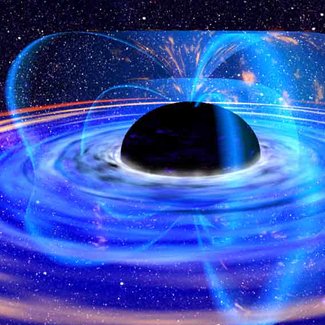Mini black holes reveal their true power

BLACK HOLES MAY BE a thousand times more powerful than anyone thought according to new findings from an international team of astronomers, and based partly on readings from the CSIRO Compact Array telescope near Narrabri in New South Wales.
If the discovery is proven to be correct then “the whole physics changes, in terms of how we explain these black holes and what they do,” says team member Tasso Tzioumis of CSIRO Astronomy and Space Science in Marsfield, NSW.
A black hole is a region of space with such a strong gravitational pull that nothing can escape from it – not even light. Black holes are sometimes created when a star collapses under the weight of its own gravity.
In the early Universe, most black holes were extraordinarily big, with masses millions to billions of times that of our Sun. Astronomers know from the few giant black holes remaining, that they can blast out huge jets gas and dust as they consume matter, which can stretch millions of light-years into space.
Bonsai black hole
These jets heat the gas they travel though. And since this gas forms the raw material for stars, knowing more about the jets, and how they might affect the gas, should help astronomers better understand the key factors involved in star formation.
But the sheer size of the few massive black holes that are left in the Universe makes them difficult to study. “Because they’re so big, they take a very long time to change – it can be many thousands of years before anything much happens,” says Tasso. They’re also many millions of light-years away.”
Tasso and his colleagues found what they have called a ‘bonsai’ black hole, a miniature black hole, or ‘microquasar’ called S26, sitting in a relatively nearby galaxy, 13 million light-years from Earth. This miniature black hole changes very quickly, making it ideal to study, and provides a small-scale model for understanding just what the bigger ones can do.
The team used telescopes in Europe and the United States to gather optical and X-ray data on the black hole. The CSIRO Compact Array, which has recently been upgraded, measured the radio waves that it produces.
Unknown power
Armed with all these results, the scientists concluded that instead of a mini black hole’s energy going into the glow surrounding it, 99.9 per cent of the energy actually goes into heating the gas around it. This heat makes for powerful jets – about a thousand times more powerful than scientists had previously thought. The hotter jets could facilitate star formation, some scientists think.
“This is a very interesting finding,” says Dr James Miller-Jones, an expert on this particular kind of miniature black hole at Curtin University in Perth, Western Australia. “For the first time, we’re able to get a really good grasp of what is going on, and to put accurate numbers on things like the amount of energy being pumped out in the jets.”
Exactly what this means for understanding things like star formation isn’t clear yet. But the work does give astronomers a better understanding of the fundamental physics of black holes, says Tasso.
A recent upgrade to the Compact Array, which makes it five to ten times more sensitive, was vital for the work, James adds. “The new sensitivity of the telescope has been crucial for enabling this study.”
The work has been published in the Monthly Notices of the Royal Astronomical Society.
RELATED STORIES
‘Extinct’ galaxy stuns astronomers
Aussie amateur spots Jupiter impact
Two asteroids will narrowly miss Earth

